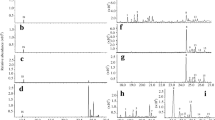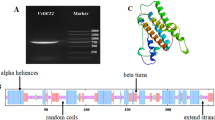Abstract
Plant triterpenoids are a diverse group of secondary metabolites with wide distribution, high chemical diversity and interesting pharmacological and antimicrobial properties. The first step in the biosynthesis of all triterpenoids is the cyclization of the 2,3-oxidosqualene precursor, catalyzed by oxidosqualene cyclases (OSCs), which have characteristic product specificities. Biosynthesis and functions of pentacyclic triterpenes have been poorly studied in grapevine. In this study, we first investigated the profile of triterpenoids present in leaf cuticular waxes from eight Vitis vinifera cultivars cultivated in the Upper Rhine Valley. Further quantification of triterpenoids showed that these cultivars can be divided into two groups, characterized by high levels of lupeol (e.g., Pinot noir) or taraxerol (e.g., Gewurztraminer) respectively. We further analyzed the OSC family involved in the synthesis of pentacyclic triterpenes (called VvTTPSs) in the sequenced V. vinifera 40024 genome and found nine genes with similarity to previously characterized triterpene synthases. Phylogenetic analysis further showed that VvTTPS1–VvTTPS3 and VvTTPS5–VvTTPS9 belong to the β-amyrin synthase and multifunctional triterpene synthase clade, whereas VvTTPS10 belongs to the lupeol synthase clade. We studied the expression of several members of the VvTTPS family following biotic and abiotic stresses in V. vinifera 40024 as well as in the eight healthy cultivars. This study further revealed that one candidate gene, VvTTPS5, which does not belong to the lupeol synthase clade, is highly expressed in lupeol-rich cultivars. VvTTPS3, VvTTPS5, VvTTPS6, VvTTPS7 and VvTTPS10 were highly upregulated by UV stress, but only VvTTPS3, VvTTPS5, VvTTPS6 and VvTTPS10 were upregulated following downy mildew and gray mold infections respectively. These results suggest differential roles of VvTTPS against environmental stresses in grape leaves.






Similar content being viewed by others
Abbreviations
- GC–MS/FID:
-
Gas chromatography–mass spectrometry/flame ionization detector
- OSC:
-
Oxidosqualene cyclase
- TLC:
-
Thin-layer chromatography
- TTPS:
-
Triterpene synthase
- t R :
-
Retention time
- UV:
-
Ultra-violet
References
Abe I, Prestwich GD (1995) Identification of the active site of vertebrate oxidosqualene cyclase. Lipids 30:231–234
Agrelli J, Oleszek W, Stochmal A et al (2003) Herbivore-induced responses in alfalfa (Medicago sativa). J Chem Ecol 29:303–320
Augustin JM, Kuzina V, Andersen SB, Bak B (2011) Molecular activities, biosynthesis and evolution of triterpenoid saponins. Phytochemistry 72:435–457. doi:10.1016/j.Phytochem.01.015
Basyuni M, Oku H, Tsujimoto E et al (2007) Triterpene synthases from the Okinawan mangrove tribe, Rhizophoraceae. FEBS J 274:5028–5042. doi:10.1111/j.1742-4658.2007.06025.x
Batovska DI, Todorova IT, Bankova VS et al (2008) Seasonal variations in the chemical composition of vine-grape leaf surface. Nat Prod Res 22:1231–1236. doi:10.1080/14786410701725865
Batovska DI, Todorova IT, Parushev SP et al (2009) Biomarkers for the prediction of the resistance and susceptibility of grapevine leaves to downy mildew. J Plant Physiol 166:781–785. doi:10.1016/j.jplph.2008.08.008
Berli FJ, Moreno D, Piccoli P et al (2010) Abscisic acid is involved in the response of grape (Vitis vinifera L.) cv. Malbec leaf tissues to ultraviolet-B radiation by enhancing ultraviolet-absorbing compounds, antioxidant enzymes and membrane sterols. Plant Cell Environ 33:1–10. doi:10.1111/j.1365-3040.2009.02044.x
Boso S, Kassemayer HH (2008) Different susceptibility of European grapevine cultivars for downy mildew. Vitis 47:39–49
Casado CG, Heredia A (1999) Structure and dynamics of reconstituted cuticular waxes of grape berry cuticle (Vitis vinifera L.). J Exp Bot 50:175–182. doi:10.1093/jxb/50.331.175
De Costa F, Yendo ACA, Fleck JD et al (2013) Accumulation of a bioactive triterpene saponin fraction of Quillaja brasiliensis leaves is associated with abiotic and biotic stresses. Plant Physiol Biochem 66:56–62. doi:10.1016/j.plaphy.2013.02.003
Dereeper A, Guignon V, Blanc G et al (2008) Phylogeny.fr: robust phylogenetic analysis for the non-specialist. Nucleic Acids Res 36:W465–W469. doi:10.1093/nar/gkn180
Doster MA, Schnathorst WC (1985) Comparative susceptibility of various grapevine cultivars to the powdery mildew fungus Uncinula necator. Am J Enol Vitic 36:101–104
Fasoli M, Dal Santo S, Zenoni S et al (2012) The grapevine expression atlas reveals a deep transcriptome shift driving the entire plant into a maturation program. Plant Cell 24:3489–3505. doi:10.1105/tpc.112.100230
Gholami A, De Geyter N, Pollier J et al (2014) Natural product biosynthesis in Medicago species. Nat Prod Rep 31:356–380. doi:10.1039/c3np70104b
Gil M, Pontin M, Berli F et al (2012) Metabolism of terpenes in the response of grape (Vitis vinifera L.) leaf tissues to UV-B radiation. Phytochemistry 77:89–98. doi:10.1016/j.phytochem.2011.12.011
Golawska S, Leszczynski B, Oleszek W (2006) Effect of low and high-saponin lines of alfalfa on pea aphid. J Insect Physiol 52:737–743. doi:10.1016/j.jinsphys.2006.04.001
Gouy M, Guindon S, Gascuel O (2010) SeaView version 4: a multiplatform graphical user interface for sequence alignment and phylogenetic tree building. Mol Biol Evol 27:221–224. doi:10.1093/molbev/msp259
Guhling O, Hobl B, Yeats T, Jetter R (2006) Cloning and characterization of a lupeol synthase involved in the synthesis of epicuticular wax crystals on stem and hypocotyl surfaces of Ricinus communis. Arch Biochem Biophys 448:60–72. doi:10.1016/j.abb.2005.12.013
Guinda A, Rada M, Delgado T et al (2010) Pentacyclic triterpenoids from olive fruit and leaf. J Agric Food Chem 58:9685–9691. doi:10.1021/jf102039t
Hayashi H, Huang P, Inoue K et al (2001) Molecular cloning and characterization of isomultiflorenol synthase, a new triterpene synthase from Luffa cylindrica, involved in biosynthesis of bryonolic acid. Eur J Biochem FEBS 268:6311–6317
Hellemans J, Mortier G, De Paepe A, Speleman F, Vandesompele J (2007) qBase relative quantification framework and software for management and automated analysis of real-time quantitative PCR data. Genome Biol 8:R19
Jaillon O, Aury J-M, Noel B et al (2007) The grapevine genome sequence suggests ancestral hexaploidization in major angiosperm phyla. Nature 449:463–467. doi:10.1038/nature06148
Kemen AC, Honkanen S, Melton RE et al (2014) Investigation of triterpene synthesis and regulation in oats reveals a role for β-amyrin in determining root epidermal cell patterning. Proc Natl Acad Sci USA 111:8679–8684. doi:10.1073/pnas.1401553111
Kostyuk V, Potapovich A, Suhan T et al (2008) Plant polyphenols against UV-C-induced cellular death. Planta Med 74:509–514. doi:10.1055/s-2008-1074499
Krokida A, Delis C, Geisler K et al (2013) A metabolic gene cluster in Lotus japonicus discloses novel enzyme functions and products in triterpene biosynthesis. New Phytol 200:675–690. doi:10.1111/nph.12414
Kushiro T, Shibuya M, Ebizuka Y (1998) Beta-amyrin synthase–cloning of oxidosqualene cyclase that catalyzes the formation of the most popular triterpene among higher plants. Eur J Biochem FEBS 256:238–244
Kushiro T, Shibuya M, Masuda K, Ebizuka Y (2000) Mutational studies on triterpene synthases: engineering lupeol synthase into β-amyrin synthase. J Am Chem Soc 122:6816–6824. doi:10.1021/ja0010709
Marti G, Schnee S, Andrey Y et al (2014) Study of leaf metabolome modifications induced by UV-C radiations in representative Vitis, Cissus and Cannabis species by LC-MS based metabolomics and antioxidant assays. Mol Basel Switz 19:14004–14021. doi:10.3390/molecules190914004
Monteiro F, Sebastiana M, Pais MS, Figueiredo A (2013) Reference gene selection and validation for the early responses to downy mildew infection in susceptible and resistant Vitis vinifera cultivars. PLoS ONE 8:e72998. doi:10.1371/journal.pone.0072998
Morita M, Shibuya M, Kushiro T et al (2000) Molecular cloning and functional expression of triterpene synthases from pea (Pisum sativum) new alpha-amyrin-producing enzyme is a multifunctional triterpene synthase. Eur J Biochem FEBS 267:3453–3460
Nagaraj M, Sunitha S, Varalakshmi P (2000) Effect of lupeol, a pentacyclic triterpene, on the lipid peroxidation and antioxidant status in rat kidney after chronic cadmium exposure. J Appl Toxicol JAT 20:413–417. doi:10.1002/1099-1263(200009/10)20:5<413:AID-JAT706>3.0.CO;2-Y
Papadopoulou K, Melton RE, Leggett M et al (1999) Compromised disease resistance in saponin-deficient plants. Proc Natl Acad Sci USA 96:12923–12928
Pensec F, Pączkowski C, Grabarczyk M et al (2014) Changes in the triterpenoid content of cuticular waxes during fruit ripening of eight grape (Vitis vinifera) cultivars grown in the Upper Rhine Valley. J Agric Food Chem 62:7998–8007. doi:10.1021/jf502033s
Pezet R, Perret C, Jean-Denis JB et al (2003) Delta-viniferin, a resveratrol dehydrodimer: one of the major stilbenes synthesized by stressed grapevine leaves. J Agric Food Chem 51:5488–5492. doi:10.1021/jf030227o
Phillips DR, Rasbery JM, Bartel B, Matsuda SP (2006) Biosynthetic diversity in plant triterpene cyclization. Curr Opin Plant Biol 9:305–314. doi:10.1016/j.pbi.2006.03.004
Privat C, Telo JP, Bernardes-Genisson V et al (2002) Antioxidant properties of trans-epsilon-viniferin as compared to stilbene derivatives in aqueous and nonaqueous media. J Agric Food Chem 50:1213–1217
Radler F, Horn DHS (1965) The composition of grape cuticle wax. Aust J Chem 18:1059–1069
Reid KE, Olsson N, Schlosser J, Peng F, Lund ST (2006) An optimized grapevine RNA isolation procedure and statistical determination of reference genes for real-time RT-PCR during berry development. BMC plant Biol 6:27
Santos-Rosa M, Poutaraud A, Merdinoglu D, Mestre P (2008) Development of a transient expression system in grapevine via agro-infiltration. Plant Cell Rep 27:1053–1063. doi:10.1007/s00299-008-0531-z
Shibuya M, Zhang H, Endo A et al (1999) Two branches of the lupeol synthase gene in the molecular evolution of plant oxidosqualene cyclases. Eur J Biochem FEBS 266:302–307
Szakiel A, Pączkowski C, Huttunen S (2012a) Triterpenoid content of berries and leaves of bilberry Vaccinium myrtillus from Finland and Poland. J Agric Food Chem 60:11839–11849. doi:10.1021/jf3046895
Szakiel A, Pączkowski C, Pensec F, Bertsch C (2012b) Fruit cuticular waxes as a source of biologically active triterpenoids. Phytochem Rev Proc Phytochem Soc Eur 11:263–284. doi:10.1007/s11101-012-9241-9
Thimmappa R, Geisler K, Louveau T et al (2014) Triterpene biosynthesis in plants. Annu Rev Plant Biol 65:225–257. doi:10.1146/annurev-arplant-050312-120229
Vandesompele J, De Preter K, Pattyn F et al (2002) Accurate normalization of real-time quantitative RT-PCR data by geometric averaging of multiple internal control genes. Genome Biol 3:RESEARCH0034
Vincken J-P, Heng L, de Groot A, Gruppen H (2007) Saponins, classification and occurrence in the plant kingdom. Phytochemistry 68:275–297. doi:10.1016/j.phytochem.2006.10.008
Wang Y, Braman SK, Robacker CD et al (1999) Composition and variability of epicuticular lipids of Azaleas and their relationship to azalea lace bug resistance. J Am Soc Hortic Sci 124:239–244
Wang Z, Guhling O, Yao R et al (2011) Two oxidosqualene cyclases responsible for biosynthesis of tomato fruit cuticular triterpenoids. Plant Physiol 155:540–552. doi:10.1104/pp.110.162883
Xue Z, Duan L, Liu D et al (2012) Divergent evolution of oxidosqualene cyclases in plants. New Phytol 193:1022–1038. doi:10.1111/j.1469-8137.2011.03997.x
Acknowledgments
We thank Jean-Marc Bertsch and Hubert Straub for their kind permission for leaves collection in their vineyards. We are grateful to the Institut National de la Recherche Agronomique (INRA) Colmar for giving us the V. vinifera 40024 line and especially to Sabine Wiedemann for the P. viticola SC strain. This work was funded by the Université de Haute Alsace, the Conseil Interprofessionnel des Vins d’Alsace and by the European COST action COST-FA1303. F. Pensec was financed by a PhD fellowship from the Région Alsace.
Author information
Authors and Affiliations
Corresponding author
Ethics declarations
Conflict of interest
The authors declare that they have no conflict of interest.
Electronic supplementary material
Below is the link to the electronic supplementary material.
Rights and permissions
About this article
Cite this article
Pensec, F., Szakiel, A., Pączkowski, C. et al. Characterization of triterpenoid profiles and triterpene synthase expression in the leaves of eight Vitis vinifera cultivars grown in the Upper Rhine Valley. J Plant Res 129, 499–512 (2016). https://doi.org/10.1007/s10265-016-0797-0
Received:
Accepted:
Published:
Issue Date:
DOI: https://doi.org/10.1007/s10265-016-0797-0




